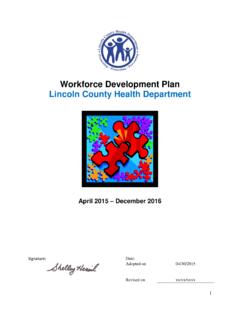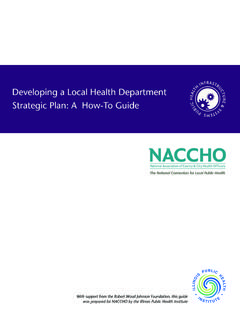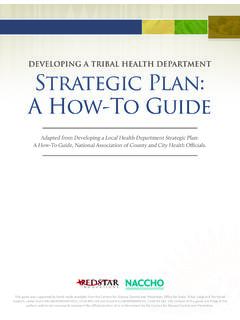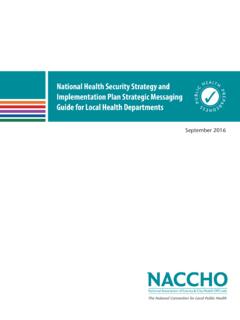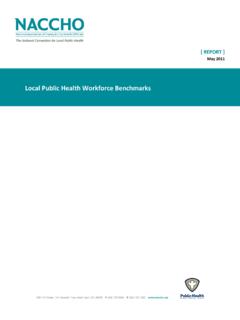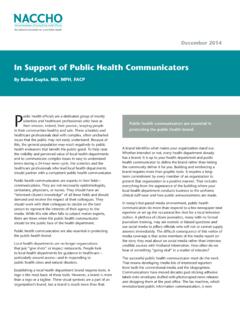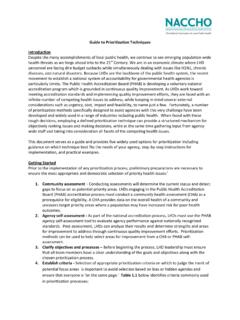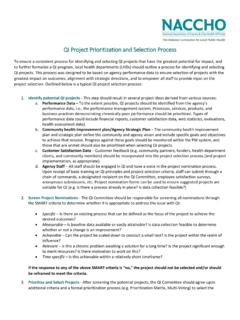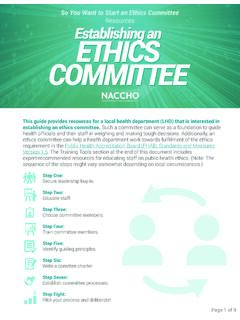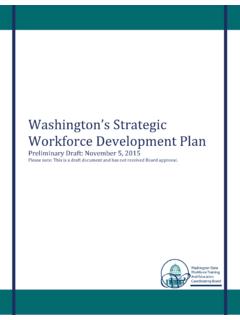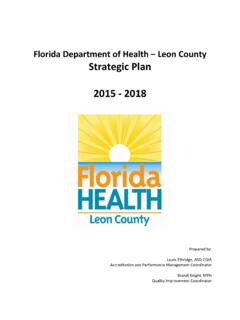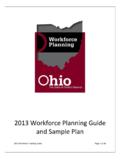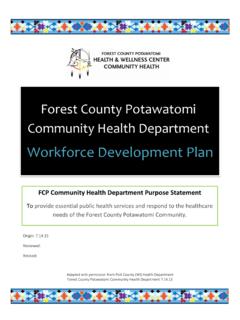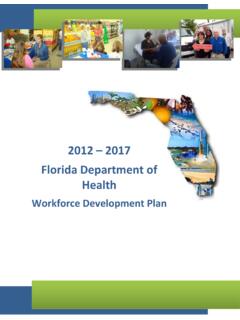Transcription of Workforce Development Plan - NACCHO
1 Workforce Development plan Siouxland District Health Department June 2016 SDHD WFD plan 1 June 2016 Workforce Development plan Table of Contents Training and Development of the Workforce is one part of a comprehensive strategy toward agency quality improvement. Fundamental to this work is identifying gaps in knowledge, skills, and abilities through the assessment of both organizational and individual needs, and addressing those gaps through targeted training and Development opportunities. This plan serves as the foundation of Siouxland District Health Department s ongoing commitment to the training and Development of its Workforce . Topic See Page Agency Profile 2 Workforce Profile* 3 Competencies & Education Requirements* 5 Training Needs* 6 Implementation & Monitoring 16 Appendices A: Workforce Development Goals 17 B: Training Schedule* 18 *These sections specifically address documentation requirements associated with PHAB Accreditation Measure SDHD WFD plan 2 June 2016 Agency Profile Mission & vision SDHD Vision: A Healthy Community for all.
2 SDHD Mission: Leading a collaborative effort to build a healthier community through improved access to health services, education, and disease prevention. strategic priorities SDHD strategic plan 2014 identified several priority areas that have guided our Workforce Development efforts and plan : Priority 1 Objective 1: Coordinated/clear vision for the future to guide service delivery Priority 4 Objective 4: Integrate the Quality Improvement (QI) Program throughout SDHD Priority 5 Objective 5: To reward employees for high performances to maintain and recruit quality public health Workforce Learning culture SDHD leadership team actively promotes a culture of learning and quality/performance improvement by encouraging role based and programmatic training, continuing education and attendance at local, state and national conferences and workshops as funding allows.
3 SDHD also holds a minimum of four (typically quarterly) All Agency Meetings each year where training for all staff is the focus. Occasional lunch and learn training/informational sessions are also offered through our employee wellness program. Our commitment to becoming a learning organization also extends to coalitions and community partnership groups we lead and participate with as we carry out our mission toward a healthy community for all. Through the gift of a previous director SDHD is able to offer a scholarship for employees working on an advanced degree. Current employees who have completed a minimum of 3 years of service are eligible to apply for the scholarship award annually. Links to other agency plans The SDHD Workforce Development plan has been in the Development stage over the past several years as evidenced by objectives set into motion from our strategic plan in 2014.
4 See strategic priorities paragraph above. Additionally, our commitment to build and support a culture of QI as stated in our QI plan directs our resolve to encourage and provide QI training for our Workforce . Our performance management plan /system is currently being developed and will include measures related to Workforce Development . SDHD WFD plan 3 June 2016 Workforce Profile The table below summarizes the demographics of our current Workforce as of May 2, 2016. SDHD Workforce Profile as of: 5/2/2016 Total # of Employees 65 # of FTE: % Paid by Grants/Contracts: 66% Tier Count Gender Count Tier 1 Front Line Staff/Entry Level 41 Female 56 Tier 2 Program Mgmt/Supervisory Level 16 Male 9 Tier 3 Sr ManagementExecutive Level 8 Race Count Age Count Hispanic 5 <20 0 Non-Hispanic 60 20-29 6 American Indian/Alaska Native 0 30-39 15 Asian 1 40-49 21 African American 3 50-59 19 Hawaiian 0 >60 4 Caucasian 61 More than One Race 0 Other 0 RETENTION RATE Primary Discipline Count <=5 years 6 to 10 years >= 11 years Leadership/Administration 7 1 0 6 Nurse 10 4 1 5 Registered Sanitarian/EH Specialist 6 3 0 3 Health Educator 1 0 1 0 Dietician 4 1 1 2 Administrative Support 11 3 1 7 Program Aide 6 6 0 0 Family Worker 3 3 0 0 Building Services 3 2 0 1 Dental Hygienist 2 1 0 1 Direct Care Worker 5 0 2 3 Quality Assurance 1 1 0 0 Health Planner 2 0 2 0 Microbiologist 2 0 0 2 Lab Technician 1 0
5 0 1 Information Technology (IT) 1 1 0 0 65 26 8 31 Employees < 4-6 years from Retirement (Tier 1) Front Line Staff 3 (Tier 2) Program Mngt. 0 (Tier 3) Senior Mngt. 0 Note approximately a third of SDHD Workforce indicated expectation to retire w/in 10 years. SDHD WFD plan 4 June 2016 Future Workforce With review of our current Workforce profile, showing 35% of current Workforce age 50 or older and the recent retirement of a few program leads we recognize the need to include leadership succession planning to capture program specific expertise to assure that capabilities are maintained for the future. Another trend we are beginning to see is the more frequent requirement for leadership positions in some program areas to hold Master s Degrees.
6 US Census data quick facts estimates show a growth in Woodbury Co. population from the 2010 Census. Anticipated population growth is expected to be modest. Data released from the Census Bureau on May 19, 2016 indicated that metro area cities in Iowa continue to grow at a modest rate. Sioux City population increased by 135 from estimates in 2014, this maintains our ranking as Iowa s 4th largest city. The median age of Woodbury County residents is which is lower than other surrounding counties. Our Hispanic or Latino population is at which is the 2nd most of all counties in our area. We utilize and appreciate the bilingual staff we currently have and will continue to recognize this need when recruiting. SDHD WFD plan 5 June 2016 Competencies & Education Requirements Core competencies for agency SDHD recognizes and utilizes the Council on Linkages Core Competencies for Public Health Professionals to ensure we reflect and build on the necessary Workforce skills and competencies to support our mission.
7 The competencies are based on the eight-domain framework developed by the Council on Linkages between Academia and Public Health Practice: 1. Analytics/assessment 2. Policy Development /program planning 3. Communication 4. Cultural competency 5. Community dimensions of practice 6. Public health sciences 7. Management 8. Leadership and systems thinking In addition to the Core Competencies listed above SDHD has identified the below competencies of importance to our Workforce Development . Emergency Preparedness & Response Skills adapted from the Public Health Preparedness & Response Core Competency Model concerned with planning, preparedness, and response to emergency events, including man-made incidents and natural disasters. Competencies and skills include: Manage behaviors associated with emotional response in self and others Maintain situational awareness (use information and resources that identify changes in the situation) Use principles of crisis and risk communication Contribute expertise to the Development of emergency plans Participate in improving the organization s capacities, including but not limited to programs, plans, policies, laws and Workforce training Maintain personal/family emergency preparedness plans Report unresolved threats to physical and mental health through the chain of command SDHD WFD plan 6 June 2016 CE required by discipline Licensures/Certificates held by staff, and their associated CE requirements, are shown in the table below.
8 Licensures, OSHA related and state mandatory reporting required trainings, and our Emergency Operations plan NIMS required trainings are tracked within an employee database. Certification CE and additional programmatic and contract requirements are tracked by division departments. Discipline Iowa CE Requirements (as of 5/16) Nursing 36 contact hours every 2 years CNA (Direct Care Workers) 12 hours annual in-service training Dietitian (RD, LD) 75 CPEUs every 5 years by the Commission on Dietetic Registration (CDR), 30 CPEUs every 2 years by the Iowa Board of Dietetics (IBD). Registered Environmental Health Specialist 24 hours Environmental Training every 2 years EBL Lead Inspector/Risk Assessor 16 hours Lead Refresher training every 2 years Certified Pool Operator 10 hours Pool/Spa training every 5 years Training Needs This section provides an overview of our agency s identified training needs as well as a description of the barriers/inhibitors to the achievement of closing these gaps.
9 (PHAB Accreditation Measure requirement) During first quarter 2016, SDHD collaborated with the Midwestern Public Health Training Center (MPHTC) to develop and administer a survey to assess our Workforce Development needs over the next three years. The centerpiece of the survey was a self-assessment of training needs for skills adapted from the Core Competencies of Public Health Professionals, a consensus set of skills for the broad practice of public health, as defined by the 10 Essential Public Health Services. Skills adapted from the Public Health Preparedness & Response Core Competency were also included. The survey was sent electronically to each of SDHD s 65 employees. 100% of SDHD employees completed a survey, and each respondent received a PDF copy of their own survey to use for individual professional Development purposes. The key findings from the aggregate analysis of all staff are outlined below.
10 The full 40 page report is available on the SDHD Share Drive or by contacting the QA/QI Coordinator. Key Findings for Training Needs and Priorities by Competency Domain This executive summary highlights the key findings for training needs and priorities, as identified from the respondents ratings and comments for specific skills in each of twelve competency domains. Domain 1 Needs and Priorities for Analytical/Assessment Skills - competencies related to collecting, analyzing, and interpreting public health data and conducting public health assessments. In this domain, skills in using information technology to collect, store, and retrieve data received the highest rating in terms of importance to the respondents jobs. This result is consistent with the majority of respondents comments, which expressed specific needs related to skills in data collection, analysis, interpretation, and reporting.

